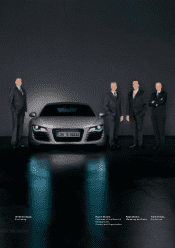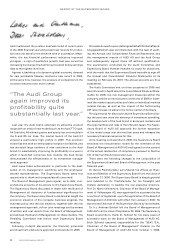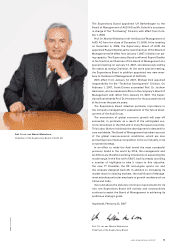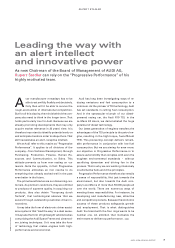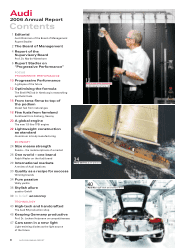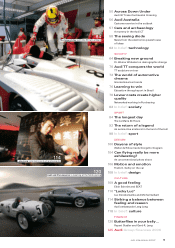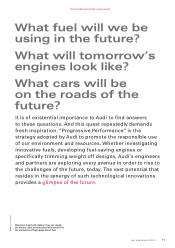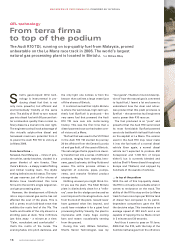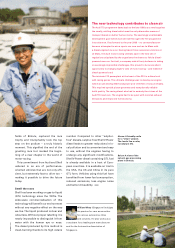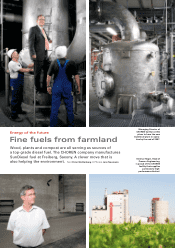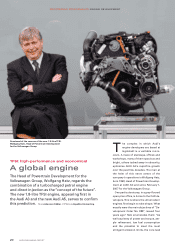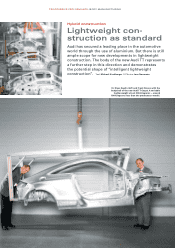Audi 2006 Annual Report Download - page 15
Download and view the complete annual report
Please find page 15 of the 2006 Audi annual report below. You can navigate through the pages in the report by either clicking on the pages listed below, or by using the keyword search tool below to find specific information within the annual report.
PROGRESSIVE PERFORMANCE: POWERED BY SYNFUEL
13AUDI 2006 ANNUAL REPORT
Shell Global Solutions’ Products,
Applications and Development
lab (or PAE for short) is home to
180 researchers who work in close coor-
dination with car companies, shipping
firms and even the Formula 1 world to
optimise fuels. The PAE lab is where the
fuel for Michael Schumacher’s racing
cars was created. And it also formulated
the special diesel fuel which the Audi
R10 TDI used to win the Le Mans 24
Hours and the American Le Mans Series
at the very first attempt last year.
But the PAE lab concerns itself with
more than just high revs. It is preparing
the way for an even more environmen-
tally friendly future. One of the stan-
dard-bearers of this advance is the
gas-to-liquid (GTL) fuel which is ob-
tained by converting natural gas into
synthesis gas with the aid of oxygen
and steam, and then into liquid hydro-
carbon. High-grade fuel for diesel en-
gines is then derived from this by frac-
tional distillation. The colourless and
odourless liquid is sulphur-free. It con-
tains neither aromatic compounds nor
organic nitrogen.
Marked reduction in pollutants
The synthetic fuel significantly reduces
pollutant emissions, assures Dr. Wolf-
gang Warnecke, Director of the PAE lab.
Warnecke is responsible for Shell’s
worldwide fuel development activities.
The engine and fuel expert refuses to be
drawn on precisely how low-pollution
it is. Because reducing pollutants de-
pends very much on making exhaust
emissions treatment more effective and
combustion methods more efficient.
Such factors are determined by engine
developers at car companies rather
than fuel experts.
SynFuel
Synthetic fuels, or SynFuels, are produced
from synthesis gas obtained either from
natural gas or from biomass. If natural gas is
the raw material, this is referred to as a gas-
to-liquid (GTL) process, and if biomass is the
basis, it is a biomass-to-liquid (BTL) process.
If obtained from natural gas, the fuel is called
SynFuel and if from biomass, it is referred to
as SunFuel.
But Warnecke is optimistic about the
manufacturers. “When many of us start-
ed studying Engineering,” he recalls, “it
was the case that all manner of concepts
were being created to optimise engines,
but that the fuel was an off-the-shelf
product with hard-and-fast specifica-
tions. The position now is that engines
are being developed to suit the fuels. The
fuel has become one of the key para-
meters.” In a nutshell, the fuel researchers
from Shell are increasingly encountering
innovations at the hardware end in their
partnership with Audi and Volkswagen.
Fuel and engine development activities
are proving mutually beneficial.
GTL is still a relatively new process.
Shell has been producing SynFuel in
Malaysia for the past few years, at the
rate of 14,700 barrels per day. Two years
ago, GTL fuel was launched at the group’s
European filling stations under the name
of V-Power diesel. Others are following
suit: the South African energy group
Sasol is opening a second industrial
plant in Qatar in the first half of 2007.
Shell intends to erect a large-scale
plant, again in the Emirate of Qatar, >>
In the production of
high-grade diesel fuel
from biomass (BTL),
plants are completely
processed.


